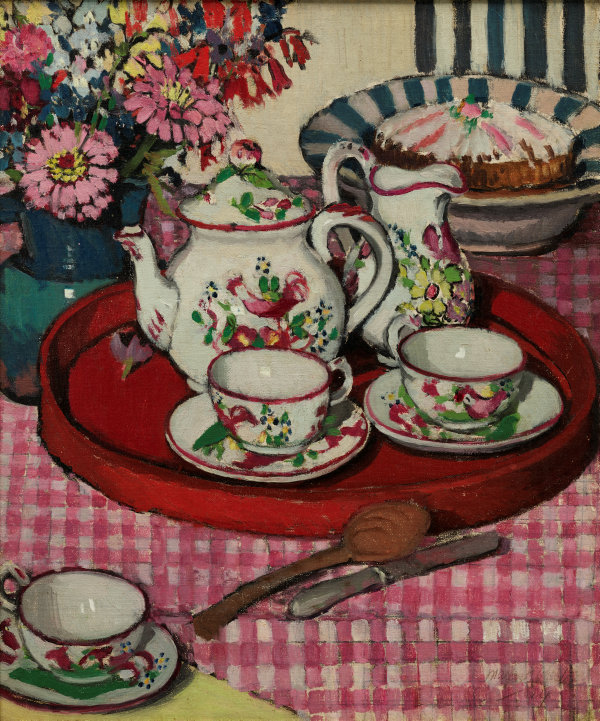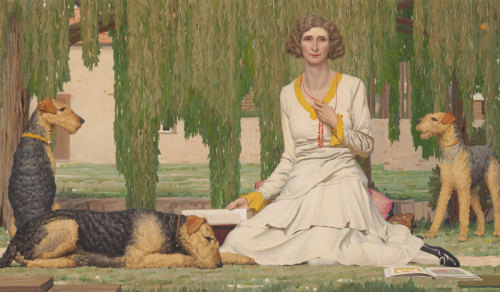According to visitor feedback, this is the ‘most-loved Australian landscape painting’ in the gallery. Elioth Gruner painted it in 1919 en plein air at Emu Plains. The cattle breath and morning shadows reaching out to the viewer, hark back to a rural nostalgia which was rapidly disappearing. The vigorous foreground brushwork and the sense of light and tone create a wistful world worth fighting for.
I also like his later work, which is more severe in form and outline. By emphasising the subtle harmonies of tone and colour, he creates a feeling of stability and permanence in contrast to his former exploratons into the evanescence of light. These organised pictures are more scientific and less emotional, but the landscape is familiar to me, with the sweep of hills to the valley river corridor, being the view from the back of our house.
 |
| On the Murrumbidgee (1929) - Elioth Gruner |
This particular portrait was painted in her father's studio (which we have visited), with the Vermeer prints on the walls. Nora wrote, "I greatly admired Vermeer’s works and wanted to paint like him – perhaps Vermeer and my father were my biggest influences in those days …"
 |
| Self Portrait (1932) - Nora Heysen |
 |
| Summer (1915) - Margaret Preston |
"Her engaging play with reflections, a device she returned to throguhout her long painting career, shows another landscape mirrored in the teapot. A hammock of pink cradles a solitary figure in a long dress holding a parasol ad standing in a green field with a blue sky, so introducing a human element to the painting's design. The figure could be the viewer or a partaker returning to the afternoon tea."
 |
| Still life with daisies and teapot (1915) - Margaret Preston |
 |
| Flowers (1922) - Margaret Preston |
 |
| Australian gum blossom (1928) - Margaret Preston |
 |
| The Proctor's tea party (1924) - Margaret Preston |
The restricted palette and strict analysis of form in this painting reveal how she turns to the genre of still life to express her conceptual conflict. The domestic vessels have been renamed 'implements' and reduced to essential forms.
 |
| Implement Blue (1927) - Margaret Preston |
 |
| Self Portrait (1930) - Margaret Preston |
The subject of the painting is Madge, the artist’s sister, knitting socks for soldiers serving on the frontline in World War I. Distinctly modern in its outlook, The sock knitter counterpoints the usual narratives of masculine heroism in wartime by focusing instead on the quiet steady efforts of the woman at home.
 |
| The sock knitter (1915) - Grace Cossington-Smith |
 |
| The Prince (1920) - Grace Cossington-Smith |
Reinforcements, troops marching (1917) - Grace Cossington-Smith
Inspired by the art deco designs and vivid colours of the David Jones department store cafe in Sydney, The Lacquer Room embodies the modern inter-war urban experience. The rich red and scattered patterns of the chairs are contrasted with the gleaming green of the lacquered tables, set against the brightness of the walls and polished floors. Grace Cossington Smith’s bold approach to colour exudes a sense of celebrating the new, similar to the contemporary consumer culture epitomised by the department store.
In an interview, she said, "It was quite a surprise, I didn't know it was there, but I went down to get cup of tea … and found this lovely restaurant … I was struck by its colour and general design the moment I saw it … Scarlet, green and white held me spellbound..."
 |
| The Lacquer Room (1935-36) - Grace Cossington-Smith |
After Fox’s death in 1915, Carrick lived mostly abroad, travelling in Europe, painting in Majorca, Egypt, Morocco, Tunisia and India, and in the 1930s living in Kashmir. Her paintings commonly displayed an interest in figures, objects and her surrounding environment, rendered as patterns of colour and light.
 |
| Flower Market, Nice (1926) - Ethel Carrick |


.jpg)
.jpg)
.jpg)
.jpg)
.jpg)
.jpg)
.jpg)
.jpg)
.jpg)
.jpg)
.jpg)
.jpg)
.jpg)









